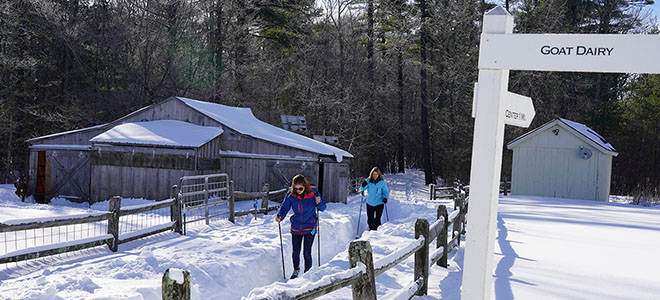
Did you know that Vermont was the first state to ban slavery, doing so in its 1777 Constitution? Despite being an early advocate of abolition, it’s not inconceivable that this majority White state—with its 94 percent Caucasian population—may not be the most attractive to newcomers of color.
It’s that image of Vermont that Curtiss Reed, Jr., executive director of Vermont Partnership for Fairness and Diversity and a Brattleboro resident, sought to reshape by recognizing both Vermont’s Abenaki heritage and the state’s growing diversity. When Peter Shumlin (D) won the 2010 gubernatorial election, he reached out to Reed for suggestions to better diversity, equity, and inclusion; one of those suggestions was backing Reed’s brainchild, the Vermont African American Heritage Trail.
“The Agency [of Commerce and Community Development] saw the immediate benefit to the economy by drawing more tourists to the state, those that are interested in cultural tourism,” said Reed in a Zoom interview. On January 15, 2013—Martin Luther King, Jr.’s birthday—the cultural trail was unveiled. It consisted of 10 historic sites illustrating Vermont’s Black heritage and its contributions to modern society.
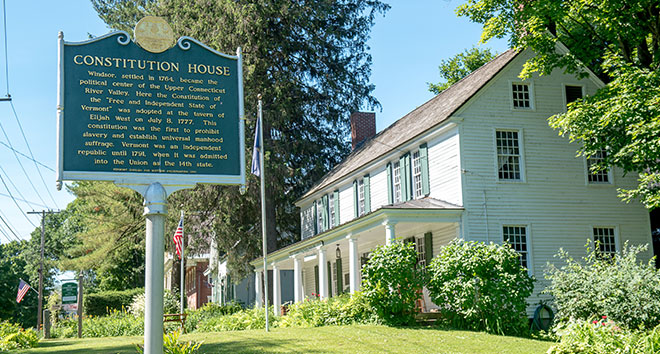
Today, the heritage trail includes 30 sites around Vermont and the New York-side of the Champlain Valley, said Reed. Examples include the Old Constitution House, a tangible reminder that Vermont was the first state to prohibit slavery, located in Windsor; there’s also the Rokeby Museum, previously home to four generations of the Robinson family, which served as a hideaway in Ferrisburgh for escaped slaves.
Reed will discuss the Vermont African American Heritage Trail in depth, along with challenges to attracting a more diverse tourism base, during his upcoming presentation in the Green Mountain Club’s speaker series (March 4; register here).
In the meantime, we’ve compiled a few ways to explore the heritage trail now with nearby hikes, trails, and walking tours. Celebrate Vermont’s Black history while also enjoying the outdoors and following COVID-19 safety precautions.
Interview with Curtiss Reed, Jr., via Zoom:
Reed’s answers have been slightly edited for length and clarity. Reed was compensated for his time.

What inspired the idea of an African American Heritage Trail and moved you to initiate it?
At the 30,000-foot level, what we’re working with is trying to make Vermont the most inclusive and equitable destination in the nation. And when we drop down to about 20,000 feet, our mission statement is how do we make Vermont the most desirable destination for People of Color?—be they tourists, convention goers, outdoor enthusiasts, [or] entrepreneurs. The full range of the experiences for folks of color could well find their way into Vermont if only they knew Vermont existed.
So the idea of the trail was as the bait… that would say to folks of color—around the country, if not around the world—that Vermont is a destination. There’s a reason to come to Vermont and that reason is there is a lot of historical, cultural events and individuals that are steeped in Black culture.
What was the process like bringing the heritage trail to fruition?
They [Governor Shumlin and his team] loved the idea [of the Heritage Trail] because it meant dollars, [it] meant attracting a whole new demographic to the state, and that was 2010. So 2010, ’11, and ‘12, the [Vermont] Department of Tourism and I worked on the trail, the contours. We had already identified 95 sites, but they were not all suitable for what we wanted to do, which was you needed to have something that you could touch, something that was documented. We started off with those 10 initial sites [in 2013], so that’s the background story.
Learn more about how the Trail was developed at Curtiss’s March 4 speaker session.
What’s your favorite stop along the trail?
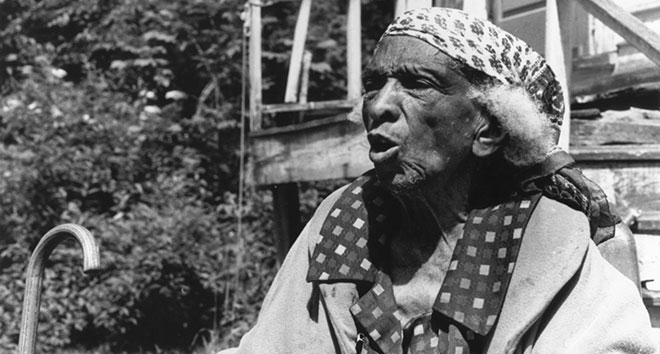
Hands down, it is Grafton, Vermont. The Turner Wildlife Reserve and the Turner family’s homestead—it is all the things that Vermont stands for. [There was] one woman with a strong voice, Daisy Turner. Her father, Alec, was a real, kind of grit, salt-of-the-earth guy; [he] eked out a living both as a logger, farmer, and hunter. The family was also really involved in local politics. They believed in the judicial system to defend their rights, and Daisy had gone to court a couple times and won cases. And you stand at the top of Journey’s End and it’s an absolutely gorgeous site.
What is your experience as a Black Vermonter?
I will give you my individual point of view. It’s not a perspective that represents all Black and Brown Vermonters. I’m bullish on Vermont. I love Vermont. I’ve been here for 42 years, and it has afforded me a high quality of life in terms of outdoor recreation, although I’m aging out of that part of my life.
But in terms of living on a human scale, I feel like, when I’m walking around [Brattleboro], it’s hard to make it from one stoplight to the other—there are only two stoplights in town—but it’s a place that everyone sort of knows each other. I feel that I’m a member of this community. I feel like my voice is heard here in way that has changed our community for the better. I raised three kids here. They’re all successful; they went through the schools here and are doing well in life. I love Vermont.
What can folks expect during your presentation?
You can expect me talking about my favorite sites. I will strongly encourage everyone to visit all sites on the trail. I’ll also talk about the challenges of attracting a more diverse tourism base and how it’s not as easy as it would appear to be. March 4; register here.
How has COVID-19 affected the experience of the heritage trail?
Because it’s wintertime, [most] of the sites are all closed. But we will see this upcoming tourism season. Last season, no one traveled. All the sites were closed. This year we’re expecting to see some more traffic.
Want to explore the Vermont African American Heritage Trail in a COVID-safe, outdoorsy way? Here are GMC’s suggestions for family-friendly hikes and walks nearby or onsite at some of the heritage trail’s premiere locations.
Trail Suggestions:
The Rokeby Museum
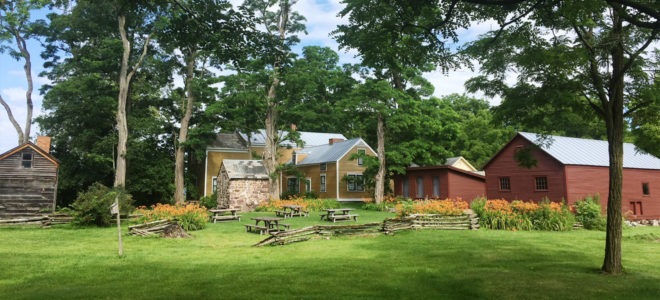
The Rokeby property, located on Route 7 in Ferrisburgh, was home to four generations of the Robinson family. This family included Quaker farmers and abolitionists who opened their home to escaped slaves traveling north through the Underground Railroad. The home is now a museum and a National Historic Landmark.
While the museum is currently closed for the season, it offers virtual programs, a book group, and—our favorite—free walking trails. The trails and parking area are currently accessible and offer views of the two ponds and waterfall. Staff recommend snowshoes and/or Microspikes, and pets are welcome (but don’t forget your poop bags!) You can also wander the 90-acre property and view the exterior of its 16 landmarks—including building foundations, a creamery, and a smokehouse.
Plan ahead: Bathroom facilities are closed. View the trail map here. The museum buildings will reopen May 9 through October 25. Find more information at rokeby.org.
Hildene, the Lincoln Family Home

In 1905, Robert Lincoln (son of Abraham Lincoln) built his home in Manchester while serving as president of the Pullman Palace Car Company. The train car manufacturer became the largest employer of African Americans in the country by the 1900s. Despite the exploitation of Black porters, the employer supported the rise of the Black middle class.
The 412-acre estate, which housed three generations of the presidents’ descendants, includes 12-miles of walking trails that are available year-round. Visitors can explore 600 feet of floating boardwalk through the Battenkill wetland, an observation platform for the bobolink sanctuary, and the 1903 Pullman Car, Sunbeam. Staff recommend snowshoes and/or skis for your exploration around the trails and estate, but pets are not allowed. Download your map here.
Plan ahead: Pets are not allowed on the trails. Bring your snowshoes or skis for easier access on trails and around the estate; rentals available. Restrooms are accessible, and the museum is open for self-guided tours; face masks are required. Find more information at hildene.org.
Turner Hill Wildlife Management Area
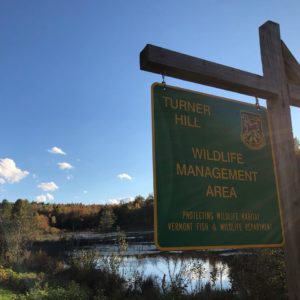
Located on this 595-acre property are the homestead site and five acres that previously belonged to Alexander ‘Alec’ Turner. Turner, a former slave, moved to Grafton in 1892 and made a living as a logger and sawmill worker. On site, you’ll find rock foundations and agricultural remnants, two cellar holes, and stone walls that remind us of Turner’s accomplishments. Learn more about the Turner family at the nearby Grafton History Museum and Turner Hill Interpretive Center.
The landscape is comprised of a typical hardwood forest and a plateau that overlooks the Saxtons River. The wetlands surrounding the river include rare plants, a colony of herons, and beaver, making it a great vantage point for birding and wildlife watching.
There are no established trails on the property, but hiking, walking, and snowshoeing are popular activities. Because beavers are active under the ice, its thickness is unpredictable; for your safety, stay off the ponds and streams. Hunting is allowed in the fall, in accordance with state Fish & Wildlife regulations.
Plan ahead: Download a map here, and be sure to review authorized activities.
Marsh-Billings-Rockefeller National Historical Park
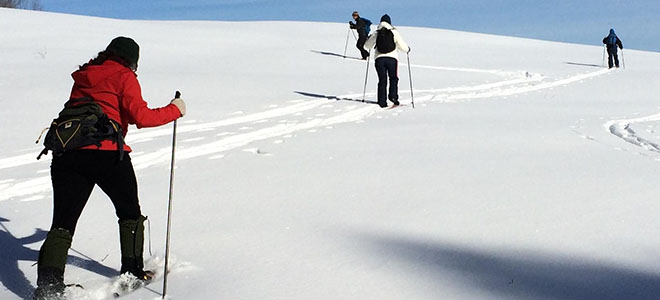
During the Civil War, 152 Black Vermonters served in the Union Army. That includes George Hart, a freed slave who joined the Massachusetts 54th Regiment, which is recognized as the first all-Black regiment formed for the Union Army. Hart settled in Woodstock after the war.
You can learn more about the home front, the broader social context of the Civil War, and Woodstock’s abolitionist history with self-guided walking tours available for download as a PDF or iPhone app.
The national historical park also includes 12 miles of groomed trail as part of its Nordic trail network; you can purchase a ski or snowshoe pass at the Woodstock Nordic Center on Route 106. There are also four miles of multi-use trails available to walkers, free of charge. You’ll also find more than 20 miles of hiking trails between the park and the abutting Billings Farm, appropriate for any season.
Plan ahead: Find your winter trail map here. Pets are allowed; pet waste must be carried offsite. All park buildings are currently closed, and no in-person programming is scheduled. Find more information at nps.gov/mabi.
Check out all the heritage trails sites, and look for the updated brochure ahead of the tourist season.



















[…] a snowshoe, cross-country ski, or walk around the grounds for the full experience. Check it out: An Outdoor Visit to Vermont’s Black History. You can also check out GMC’s presentation with the heritage trail’s founder, Curtiss […]